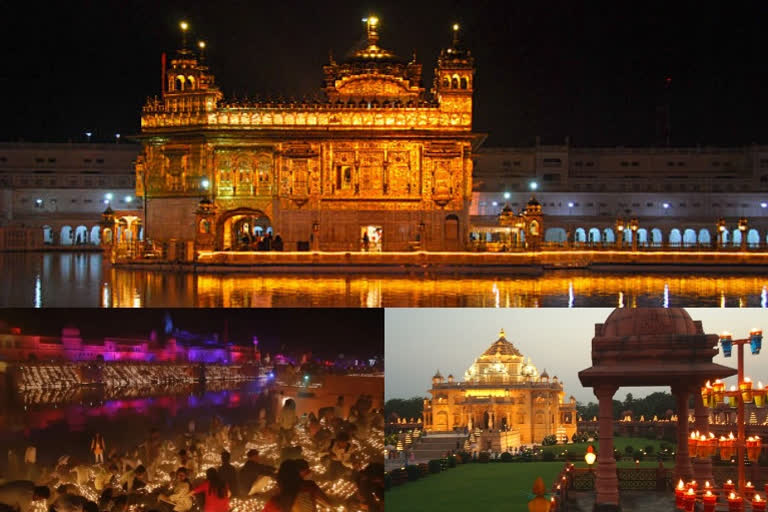Hyderabad: Also known as the festival of lights, Diwali or 'Deepavali' is widely celebrated by Indians all across the world. Even though the significance of this festival differs from region to region, lighting a clay lamp at temples and in homes is a common ritual.
In the northern regions of India, Diwali is celebrated as the mark of Lord Ram's triumphant return to Ayodhya from his exile and after his victory over Ravan, while in the southern regions it is celebrated because Lord Krishna and his consort Satyabhama slayed the demon Narakasur. Interestingly, Diwali is also celebrated by Sikhs and Jains. Sikhs observe the day when Mughal emperor Jahangir released Guru Hargobind. To Jains, it is the day when Mahavir attained Nirvana.
Also read:A guide for diabetics to celebrate a Healthy Diwali in 2022
Many regions relate the day with the appearance of Goddess Lakshmi during the 'Samudra Manthan' or churning of the ocean of milk which took place between the gods and demons; hence a few communities observe the day as the start of the New Year. The five-day Diwali celebrations usually begin on the day of Dhanteras an auspicious ritual for people to buy gold and end at Bhai Dooj where sisters offer prayers for their brothers’ health. Different communities perform different rituals during these five days. Different regions in the country celebrate Diwali:
Uttar Pradesh:
Ayodhya And Varanasi are well known for the celebration of Deepotsav and Dev Deepavali respectively. Ayodhya celebrates Diwali by lighting millions of clay lamps on the bank of the river Sarayu, while Varanasi celebrates Dev Deepavali (Diwali of the Gods) by offering Clay lamps to the river Goddess Ganga.
Punjab:
Diwali marks the advent of winter in Punjab. Farmers start preparing for the farming season and sow the first batch of seeds. Sikhs observe ‘Bandi Chhor Diwas’ that falls on the same day as Diwali. The Golden Temple is lit up with thousands of clay lamps and fireworks and a ‘langar’ (free kitchen) caters to those who come to offer their prayers at the sacred site.
West Bengal:
Bengal celebrates it by welcoming the goddess Kali as Diwali coincides with Kali Puja. Usually, Kali Puja is held at night. Elaborate celebrations take place at all the Kali temples, while in many homes Lakshmi Puja is also observed. The evening is usually devoted to bursting firecrackers. Kalighat and Dakshineshwar temples in Kolkata are famous for organising Kali Puja.
Gujarat:
For the Gujarati community, Diwali marks the end of the traditional year. Elaborate preparations are made for holding Lakshmi Puja, as on the day of Labh Pancham (the fifth day after Diwali), the celebration concludes with the restarting of business for the New Year. The festival begins with Vaag Baras, followed by Dhanteras, Kali Chaudash, Diwali, Bestu Varas, and Bhai Bij.
Maharashtra:
Diwali celebrations in Maharashtra begin with Vasu Baras held in the honour of cows. On the day of the festival, Maharashtrians pray to goddess Lakshmi and also observe Diwali Cha Padva which celebrates the bond of marriage. The festivities come to an end with Bhaav Bij and they welcome the wedding season with Tulsi Vivah.
Goa:
In Goa, Diwali is celebrated in honour of Lord Krishna who slays the demon, Narkasur. Effigies of Narkasur are paraded through the streets before they are burnt. This marks the commencement of the festival of light and the end of evil and darkness. On this day, people in Goa and several parts of South India smear coconut oil on themselves to absolve themselves of sin - a practice similar to pilgrims taking a dip in the holy river Ganga, in North India.
Tamil Nadu:
Celebrations for Deepavali in the southern states of India begin the day before. Narak Chaturdashi is the main day of the festival for the southern region of the country. In Tamil Nadu, the day begins with an oil bath before sunrise, and a plethora of rituals are followed during the period. Tamilians light the ‘Kutthu Velakku’ (lamp) and offer ‘Naivedhyam’ to deities. A mixture of rice powder or increasingly white or coloured chalk called Kolam is drawn in front of house entrances, and even on streets. They also perform the 'Pithru Tharpanam' Puja to appease their ancestors.
